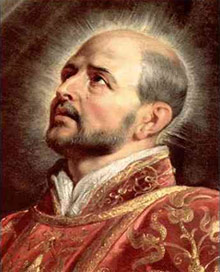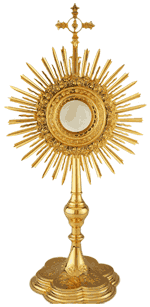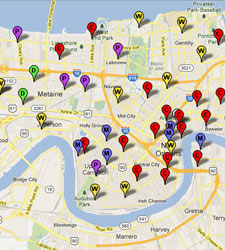Rectory 504-899-1378 | Fax 504-899-0480
School 504-891-1927
ststephenpar@archdiocese-no.org
From the Pastor – July 28, 2024
 Then Jesus took the loaves, gave thanks, and distributed them to those who were reclining, and also as much of the fish as they wanted. When they had had their fill, he said to his disciples, “Gather the fragments left over, so that nothing will be wasted.” So they collected them, and filled twelve wicker baskets with fragments from the five barley loaves that had been more than they could eat. When the people saw the sign he had done, they said, “This is truly the Prophet, the one who is to come into the world.” (Jn 6:11-14)
Then Jesus took the loaves, gave thanks, and distributed them to those who were reclining, and also as much of the fish as they wanted. When they had had their fill, he said to his disciples, “Gather the fragments left over, so that nothing will be wasted.” So they collected them, and filled twelve wicker baskets with fragments from the five barley loaves that had been more than they could eat. When the people saw the sign he had done, they said, “This is truly the Prophet, the one who is to come into the world.” (Jn 6:11-14)
If you regularly attend Mass at the Basilica of St. Stephen, you know that it is rare when I don’t mention the Blessed Sacrament of the Holy Eucharist in a homily. Since Mass is divided into two parts, the Liturgy of the Word and the Liturgy of the Eucharist, I want my homily to be a bridge that leads from the Word to the Eucharist. But the readings for Mass over the next six weeks gives us an opportunity to go a little further. Beginning this weekend on the 17th Sunday of the Ordinary Time and ending on the 21st Sunday (August 25) we will hear entirely the 6th Chapter of John’s Gospel. It’s called the “bread of life discourse,” and it is the theological basis for our Catholic belief in the Real Presence of Christ in the Holy Eucharist.
John 6 begins this Sunday with the feeding of the multitudes. On August 4th Jesus discusses the “sign,” and reveals Himself as the “bread of life.” On August 11th, Jesus connects the “bread of life” to His own flesh. On August 18th Jesus drops the bombshell when He tells his followers: “Amen, amen, I say to you, unless you eat the flesh of the Son of Man and drink his blood, you do not have life within you.” And finally, on August 25th, we hear that some of the followers of Jesus cannot accept this teaching. They begin to depart. And Jesus does something unusual. He doesn’t correct Himself. He doesn’t tell them that He was only speaking in allegory. He doesn’t beg them to come back and understand. He lets them go. And then He turns to the Twelve Apostles and asks them “Do you also want to leave?” And St. Peter speaks for the group when he tells Jesus: “Master, to whom shall we go? You have the words of eternal life. We have come to believe and are convinced that you are the Holy One of God.”
As I said above, anybody who spends time our Basilica knows that I speak about the Eucharist as often as possible. Why? Because I believe what Jesus told us in John 6. Unlike the Synoptic Gospels of Matthew, Mark and Luke, which have the same viewpoint (that’s what syn -+ optic means), John’s Gospel is more deeply theological. He begins John 6 with the facts of the Multiplication of the Loaves, and then He has Jesus explaining and fore- shadowing what He will give the Apostles at the Last Supper. And the good news is that He will give us the same thing to us today: The Sacrament of His Body and Blood.
(Very Rev. Msgr.) Christopher H. Nalty
msgr.nalty@gmail.com
Masses
St. Stephen
Saturday Vigil at 4:00 pm
Sunday at 8:00 am and 10:30 am
Sunday at 5:00 pm at OLGC
Our Lady of Good Counsel (OLGC)
Center of Jesus the Lord
Charismatic Mass
Sunday at 10 am
Weekdays Masses
Monday – Friday 6:30 am St. Henry
Tuesdays 6:00 pm St. Stephen
First Fridays 6:00 pm Latin Mass
Adoration of the Blessed Sacrament
Tuesdays 4:45 – 5:45pm St. Stephen
Thursdays 7:00 – 8:00am St. Henry
Confession Times at Good Shepherd
Saturdays 3:00 – 3:45pm St. Stephen
Sundays 9:30 – 10:15am St. Stephen
Sundays 10:00 – 10:30am OLGC
First Fridays 6:30 – 7:00pm OLGC
Newsletter Sign Up
Willwoods Supper and Substance

Attention Married Couples! You are invited to the ultimate summer date night, the Faith & Marriage Apostolate’s 15th Annual Diocesan-Wide Supper and Substance on Fri., July 26th, from 5:30pm – 8:30pm at Mid City Lanes Rock ‘N’ Bowl on S. Carrollton Ave in New Orleans! This ultimate summer date night includes a powerful presentation from Jean & Janice Charbonnet, a TOTALLY 80’s dance experience from the band, L’Eighties Night, drinks at the bar, an array of classic Southern Louisiana cuisine to enjoy, and of course bowling throughout the night!
To purchase your tickets or for sponsorship opportunities go to FaithandMarriage.org.
Feast of St. Ignatius Loyola – July 31

Ignacio López de Loyola was born in Spain in 1491, the youngest of 13 children. In 1506, he adopted the last name “de Loyola” in reference of the Basque city of Loyola where he was born. In 1509, Ignatius took up arms under the Duke of Nájera and participated in many battles without injury to himself. However, on May 20, 1521, in a battle against the French, a cannonball wounded both of his legs. During his recuperation at Loyola, Ignatius read the Life of Christ by Ludolph of Saxony, a commentary on the Gospels with extracts from the works of over sixty of the Fathers of the Church; the book influenced his whole life. Ludolph proposes that the reader place himself at the scene of a Gospel story and visualize the scene in a simple contemplation.
During his recuperation at Loyola, Ignatius read the Life of Christ by Ludolph of Saxony, a commentary on the Gospels with extracts from the works of over sixty of the Fathers of the Church; the book influenced his whole life. Ludolph proposes that the reader place himself at the scene of a Gospel story and visualize the scene in a simple contemplation. He also read the lives of the saints.
When Ignatius left Loyola he had no definite plans for the future, except that he wished to rival all the saints had done in the way of penance. His first care was to make a general confession at the famous sanctuary of Montserrat, where, after three days of self-examination, and carefully noting his sins, he confessed, gave to the poor the rich clothes in which he had come, and put on garment of sack-cloth reaching to his feet. His sword and dagger he suspended at Our Lady’s altar, and passed the night watching before them. The next morning, he retired to a cave near the neighboring town of Manresa, where he retired for prayer, austerities, and contemplation, while he lived on alms.
It was at this time, too, that he began to make notes of his spiritual experiences, notes which grew into the little book of “Spiritual Exercises.”
St. Ignatius spent a number of years studying in Paris, where he became thoroughly versed in the science of education, and learned by experience how the life of prayer and penance might be combined with that of teaching and study. Starting a small society in Paris, the Society of Jesus was approved by the Holy See in 1540. He died on July 30, 1556 and was canonized in 1622.
Currently, the Jesuits are the single largest religious order in the world, numbering nearly 20,000 members, of which nearly 14,000 are priests. They work in 112 nations on six continents.
Christmas in July!
A Christmas Giving Tree has been set up next to the St. Anthony Statue. St. Vincent de Paul Society would like to be able to offer more dollars and maybe pay an entire utility bill for someone in need. All donations will be designated to assist with an utility bill payment. Take an “ornament” from the tree in the rear of church and return before the end of July. There is no need to buy a present and wrap it; the Society of St. Vincent de Paul will do the rest! God’s blessing to all of you!
Happy Father’s Day
God our Father, We give you thanks and praise for fathers young and old.
We pray for young fathers, newly embracing their vocation; May they find courage and perseverance to balance work, family and faith in joy and sacrifice.
We pray for our own Fathers around the world whose children are lost or suffering; May they know that the God of compassion walks with them in their sorrow.
We pray for men who are not fathers but still mentor and guide us with fatherly love and advice.
We remember fathers, grandfather, and great grandfathers who are no longer with us but who live forever in our memory and nourish us with their love. Amen
Ministry to the Poor at the Rebuild Center
Many of you know that our parish, largely through our St. Anthony Poor Box, feeds the poor at the Rebuild Center on almost every Thursday of the month. The meals are cooked at Our Lady of Good Counsel rectory, and then volunteers serve the food at the Rebuild Center. The list below shows how many people we have fed a nutritious meal since the beginning of this year, nearly 3000! Thanks for all you do to feed the poor through your donations to the St. Anthony Poor Box! If you would like to assist directly in cooking and feeding the poor, please call the parish office, or email Eddie Connick at edwinconnick@gmail.com.
Marriage and Sexuality
The desire to love and be loved is the deepest need of our being. We long to be known, accepted, and cherished by another. Yet, the ability to fully give or receive this love is unattainable on our own. As Catholics we believe Jesus Christ has entered our broken world to conquer sin and restore us to new life. Throughout every age he continues to invite all women and men to follow him through his Church, to whom he has entrusted his teaching authority, so that all can know and follow him.
Only God can give us the unconditional love and acceptance that we desire. Yet, he has created marriage, a holy union, to mirror this supreme love on earth. At the heart of their married love is the total gift of self that husband and wife freely offer to each other. Because of their sexual difference, husband and wife can truly become “one flesh.” Through the language of their bodies, their sexual union recalls their vows: giving themselves to one another in love that is total, faithful, and life-giving.
This call to love is to follow Christ himself, who handed himself totally over for his bride, the Church. Spouses imitate him by giving the entirety of themselves to one another, including the gift of their fertility and their openness to new life. Contraception and sterilization, which deliberately suppress fertility, reduce the sexual act so that husband and wife withhold the completeness of their total gift to each other. This changes the meaning of their sexual union so that it no longer expresses the fullness of their love.
God our Father loves us and wants our lives to be full and rich! He has given his Church the task of bringing women and men to the fullness of truth which leads to our happiness in this life and in the life to come. Jesus gives us the power and strength of the Holy Spirit—the Spirit of Love—so that we, particularly husbands and wives, can truly love one another.
The teaching on the use of contraception and sterilization may seem challenging, but it is to preserve the true, complete self-gift between husband and wife, the kind of love that brings real, lasting joy and peace. If we have failed to live this in the past, we need not be discouraged. Our loving Father is always calling us back through the Sacrament of Reconciliation and wanting to strengthen us in the Sacrament of the Eucharist.
When we embrace the Church’s teaching on human sexuality and marriage and follow Jesus, we invite the Holy Spirit into our lives in a powerful way. When we trust in the Lord’s desire for our happiness, he can transform our love in a way that can transform the world.
To learn more, visit www.usccb.org/love-and-sexuality
The Symbolism of the Pelican
During the years I lived in Rome, I spent a lot of time trying to decipher and understand early Christian symbolism. It was a hobby of mine as I visited churches and saw so much iconography. Recently, someone visited St. Stephen Church in New Orleans and asked me about an image that they saw high over the sanctuary of a pelican feeding its young. They wondered why someone would have painted the “state bird” in church! The question gave me a good occasion to reflect upon church symbolism.
The image of the mother pelican feeding her baby pelicans is rooted in several ancient Roman legends that precede Christianity. One version is that in time of famine, the mother pelican wounded herself, striking her breast with her beak to feed her young with her blood. Another version was that the mother fed her dying young with her blood to revive them from death, but in turn lost her own life.
Given these traditions, one can easily understand how early Christians adapted it to symbolize our Lord, Jesus Christ. The pelican symbolizes Jesus our Redeemer who gave His life for our redemption and feeds us with His Body and Blood in the Eucharist. We were dead to sin and have found new life through the sacrifice of Christ.
This tradition and others is found in the Physiologus, an early Christian work which appeared in the second century in Alexandria, Egypt. Written by an anonymous author, the Physiologus recorded legends of animals and gave each an allegorical interpretation. The legend is described: “The little pelicans strike their parents, and the parents, striking back, kill them. But on the third day the mother pelican strikes and opens her side and pours blood over her dead young. In this way they are revivified and made well. So Our Lord Jesus Christ says also through the prophet Isaiah: I have brought up children and exalted them, but they have despised me (Is 1:2). We struck God by serving the creature rather than the Creator. Therefore, He deigned to ascend the cross, and when His side was pierced, blood and water gushed forth unto our salvation and eternal life.” This work was noted by noted by numerous authors and was popular in the Middle Ages as a source for the symbols used in the various stone carvings and other artwork of that period.
In 1312 Dante wrote in his “Paridiso” of Christ as “our Pelican who shed His blood in order to give eternal life to the children of men.” In 1606 John Lyly wrote in his
“Euphues” of the “pelicane who stricketh blood out of its owne bodye to do others good.” In Hamlet, William Shakespeare wrote “to his good friend thus wide, I’ll ope my arms and, like the kind, life-rendering pelican repast them with my blood.”
The pelican also has been part of our liturgical tradition. In his great Eucharistic hymn “Adoro te devote,” St. Thomas Aquinas asks the pie pelicane, Jesu Domine, (the pious pelican, Lord Jesus) to “wash my filthiness and clean me with your blood.”
Those of us in Louisiana are very familiar with pelicans. Anybody who fishes in Lake Pontchartrain or along the coast are used to seeing pelicans flying across the water and perching themselves on pilings. The pelican is our state bird, and the motto of Louisiana is the “Pelican State.” Even the State Flag of Louisiana uses the image of a pelican. But interestingly enough, the image on the flag is not that of a pelican in flight or perched on a piling; it’s the familiar image taken from the Roman legend: that of a pelican feeding its young.
It shouldn’t be surprising that the pelican symbolism was employed on the front of the altar used for the final Mass when Louisiana hosted the 8th National Eucharistic Congress in October of 1939, in a crystal clear Eucharistic reference.
So an ancient secular legend was appropriated to symbolize a Christian mystery, and that symbol became a secular image familiar to anyone in Louisiana seeing the state flag. As for me, understanding the symbolism of the pelican and seeing them in nature provides a ready reminder of Christ’s redemptive love and His Real Presence in the Holy Eucharist., something to reflect on during this Year of the Eucharist in the Archdiocese of New Orleans.
Good Church Etiquette
An instructive reminder
Remember to keep your Eucharistic fast by abstaining from food and beverages (water excluded) for an hour before Mass.
Always dress modestly and appropriately. Arrive early to allow for personal prayer and/or read the readings of the day.
Turn off all mobile devices while still in the vestibule. This is your time with God and His people.
Use the restroom before or after Mass. Men remove hats or caps before the Lord.
Deposit all water bottles in the waste receptacles.
Make the sign of the cross with Holy Water upon entering.
Genuflect with great reverence towards the Blessed Sacrament in the tabernacle before entering your pew. If unable to genuflect, a profound bow is respectful.
Refrain from chit-chat which distracts others who are connecting with God through prayer before Mass.
Join the singing. St. Anselm said that “singing is praying twice.” Singing with others gives great praise to God, which is really why we are gathered here.
Listen to the readings. God is speaking directly to you.
Receive Communion with laser-like attention. We receive Communion, we do not take it. If choosing to receive the Body of Christ in the hand, place the hand you write with under the hand you will receive, in a way, creating a throne for the Lord. A simple bow of the head to the Eucharist is appropriate as a sign of reverence to Christ before receiving.
Don’t forget to make a prayer of thanksgiving after receiving Communion. “There is no prayer more agreeable to God, or more profitable to the soul than that which is made during the thanksgiving after Communion.” (St. Alfonsus Liguori)
Remember that the point of being at Mass is not to see what we can get out of it, but what you can do to praise and worship the Almighty.
And finally, leave church only after the procession has left the altar. Only one person left the Last Supper early”
Feast of St. Mary Magdalene July 22
Mary was called “Magdalen” because she was either from Magdala near Tiberias (on the west shore of Galilee) or possibly from a Talmudic expression meaning “curly women’s hair,” which means an adulteress.
In the New Testament Mary is mentioned among the women who accompanied Christ and ministered to Him (Luke 8:2-3), where it is also said that seven devils had been cast out of her (Mark 16:9). She is next named as standing at the foot of the cross (Mark 15:40; Matthew 27:56; John 19:25; Luke 23:49). She saw Christ laid in the tomb, and she was the first recorded witness of the Resurrection.
The Greek Fathers, as a whole, distinguish the “sinner” of Luke 7:36-50; Mary, the sister of Martha and Lazarus, and Mary Magdalen. On the other hand most of the Latin Fathers hold that these three they were one and the same. It is impossible to demonstrate the identity of the three through the Scriptural texts. Yet it is certainly Mary Magdalen who, according to all the Evangelists, stood at the foot of the cross and assisted at the entombment and was the first recorded witness of the Resurrection. And while St. John calls her “Mary Magdalen” in 19:25, 20:1, and 20:18, he calls her simply “Mary” in 20:11 and 20:16.
Many Scriptural scholars observe that the “sinner” in Luke comes early in the ministry of Jesus to seek for pardon; Mary is described immediately afterwards as Mary Magdalen “out of whom seven devils were gone forth”; shortly after, we find simply “Mary” “sitting at the Lord’s feet and hearing His words.”
To the Catholic mind it all seems fitting and natural. The sinner has repented, and she is no longer considered an “adultress.” At a later period Mary and Martha turn to “the Christ, the Son of the Living God,” and Jesus raises their brother Lazarus. Only a short time afterwards Mary and Martha make Jesus supper and Mary repeats the act she had performed when a penitent. At the Passion she stands nearby; she sees Him laid in the tomb; and she is the first Scriptural witness of His Resurrection (although it would have been only fitting for Jesus to have appeared first to His Mother) St. Mary Magdalen, patroness of penitent sinners, pray for us!
Home Middle #3 Widget
This is a widgeted area which is called Home Middle #3. It is using the Genesis - Featured Page widget to display what you see on the Metric child theme demo site. To get started, log into your WordPress dashboard, and then go to the Appearance > Widgets screen. There you can drag the Genesis - Featured Page widget into the Home Middle #3 widget area on the right hand side. To get the image to display, simply upload an image through the media uploader on the edit post screen and publish your page. The Featured Page widget will know to display the post image as long as you select that option in the widget interface.
Copyright © 2024 Good Shepherd Parish · New Orleans WordPress site hosting and maintenance provided by Amaze Media | Privacy Policy




